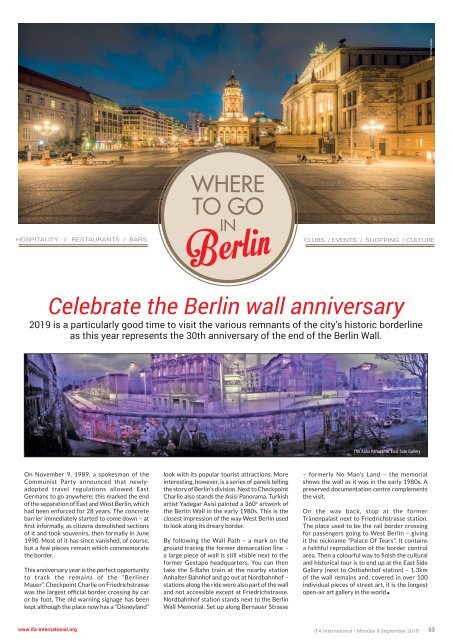IFA iNternational 2019 DAY 4 Edition
Create successful ePaper yourself
Turn your PDF publications into a flip-book with our unique Google optimized e-Paper software.
© Thomas Keller<br />
HOSPITALITY / RESTAURANTS / BARS<br />
CLUBS / EVENTS / SHOPPING / CULTURE<br />
Celebrate the Berlin wall anniversary<br />
<strong>2019</strong> is a particularly good time to visit the various remnants of the city’s historic borderline<br />
as this year represents the 30th anniversary of the end of the Berlin Wall.<br />
The Asisi Panorama, East Side Gallery<br />
On November 9, 1989, a spokesman of the<br />
Communist Party announced that newlyadopted<br />
travel regulations allowed East<br />
Germans to go anywhere; this marked the end<br />
of the separation of East and West Berlin, which<br />
had been enforced for 28 years. The concrete<br />
barrier immediately started to come down – at<br />
first informally, as citizens demolished sections<br />
of it and took souvenirs, then formally in June<br />
1990. Most of it has since vanished, of course,<br />
but a few pieces remain which commemorate<br />
the border.<br />
This anniversary year is the perfect opportunity<br />
to track the remains of the “Berliner<br />
Mauer”. Checkpoint Charlie on Friedrichstrasse<br />
was the largest official border crossing by car<br />
or by foot. The old warning signage has been<br />
kept although the place now has a “Disneyland”<br />
look with its popular tourist attractions. More<br />
interesting, however, is a series of panels telling<br />
the story of Berlin’s division. Next to Checkpoint<br />
Charlie also stands the Asisi Panorama. Turkish<br />
artist Yadegar Asisi painted a 360 o artwork of<br />
the Berlin Wall in the early 1980s. This is the<br />
closest impression of the way West Berlin used<br />
to look along its dreary border.<br />
By following the Wall Path – a mark on the<br />
ground tracing the former demarcation line –<br />
a large piece of wall is still visible next to the<br />
former Gestapo headquarters. You can then<br />
take the S-Bahn train at the nearby station<br />
Anhalter Bahnhof and go out at Nordbahnhof –<br />
stations along the ride were also part of the wall<br />
and not accessible except at Friedrichstrasse.<br />
Nordbahnhof station stands next to the Berlin<br />
Wall Memorial. Set up along Bernauer Strasse<br />
– formerly No Man’s Land – the memorial<br />
shows the wall as it was in the early 1980s. A<br />
preserved documentation centre complements<br />
the visit.<br />
On the way back, stop at the former<br />
Tränenpalast next to Friedrichstrasse station.<br />
The place used to be the rail border crossing<br />
for passengers going to West Berlin – giving<br />
it the nickname “Palace Of Tears”. It contains<br />
a faithful reproduction of the border control<br />
area. Then a colourful way to finish the cultural<br />
and historical tour is to end up at the East Side<br />
Gallery (next to Ostbahnhof station) – 1.3km<br />
of the wall remains and, covered in over 100<br />
individual pieces of street art, it is the longest<br />
open-air art gallery in the world<br />
www.ifa-international.org <strong>IFA</strong> International • Monday 9 September <strong>2019</strong><br />
53

















